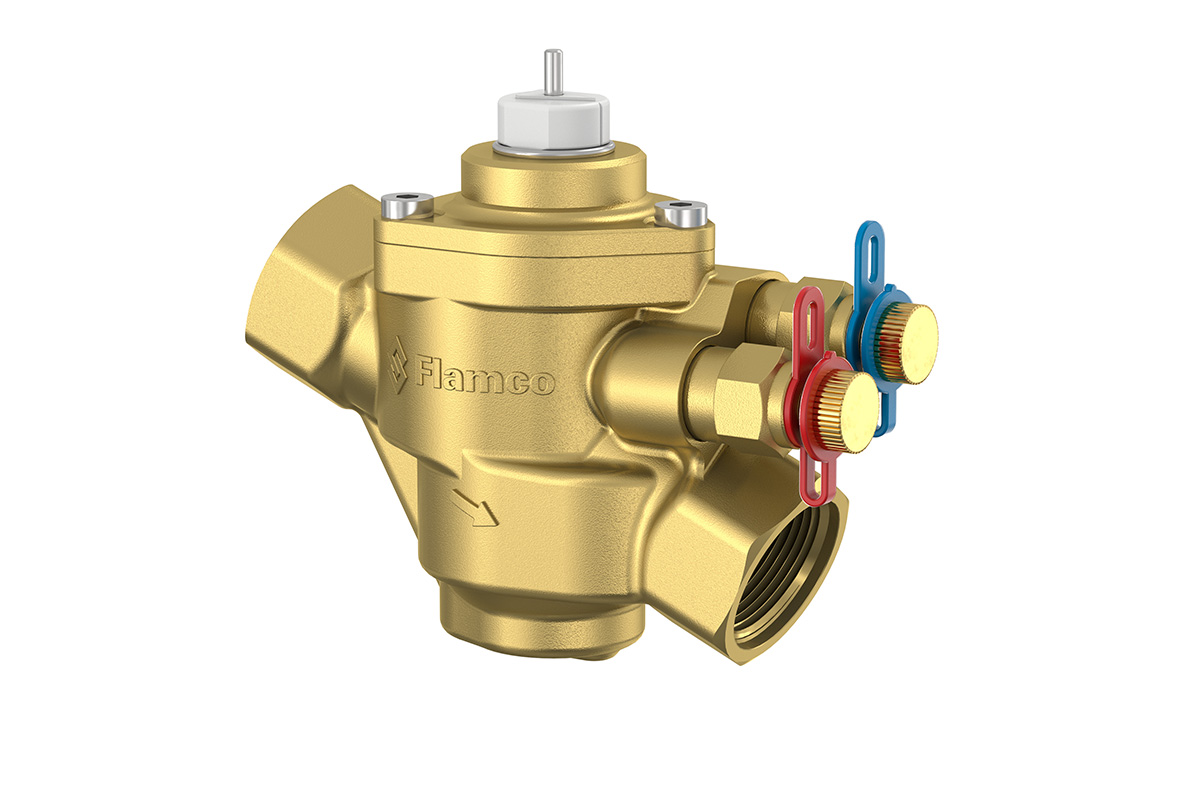
Several studies have proven that hydraulic balancing is an effective measure for increasing system efficiency. However, there are various aids for adjusting volume flows according to demand, which do not all lead to the same result. Flamco Comap has now further developed the 2-in-1 Vivax balancing and control valve of its own NexusValve brand. The NexusValve Vivax G2 EQM offers more precise and dynamic balancing.
The NexusValve Vivax G2 EQM is a combination product consisting of a differential pressure-independent flow limiter and control valve for hydraulic balancing in heating or cooling systems. The 2-in-1 solution not only reduces installation costs, the combination of the two functions also results in greater convenience. “Equipped with 100% control authority, the valve reacts immediately to changes in the upcoming differential pressure. It regulates the flow according to the signal from the building management system or the room thermostat,” explains Maxcens Fernandes, Product Line Sales Director Balancing & Control at Comap. “Without an actuator, the NexusValve Vivax G2 EQM is an automatic flow limiter. In this way, the valve ensures the intended flow in the end units, regardless of requirements from other consumers or strings in the system.”
Equal-percentage modulation
A new feature of the NexusValve Vivax G2 EQM is the equal-percentage modulating valve characteristic (EQM). By means of this, the flow control is particularly precise, independent of the differential pressure, and the unfavorable performance curve of a typical heating system is compensated. The conventional and complex hydraulic balancing is no longer necessary as the valve keeps the set flow constant regardless of the load conditions in other parts of the system. Once set, there is no need for readjustment. The result is optimal heat distribution, which prevents over-supply and, accordingly, saves more than 8% energy compared to standard control valves.
EQM characteristic for high thermal comfort
The new generation of the valve stands out due to its optimised characteristic curve: “The equal-percentage modulating characteristic curve of the NexusValve Vivax EQM and the typical characteristic curve of heating and cooling systems result in a linear overall characteristic curve that allows efficient control of the system,” says Maxcens Fernandes. Since the stroke is independent of the presetting, there is always full valve authority for precisely regulated flow control. The result: room temperatures can be kept constant and an oversupply in the system is prevented. Efficiency is increased, while at the same time the pump has to provide less power. This ultimately results in cost savings in operation. “Depending on the initial situation, energy expenditure can be reduced by up to 20%,” Fernandes says.
In addition, by checking the actual volume flow (optional), system faults are more easily detected and can be rectified without changing the flow in the terminal units already in operation. “The actual hydraulic balancing is virtually eliminated,” says Fernandes. “This is ultimately based on theoretical calculations, with which at best an approximation to an optimal state can be achieved, but which does not correspond to the real conditions.”
The EQM function is included in NexusValve Vivax G2 EQM (DN15 and DN20) but is also available for NexusValve Vivax DN25 – DN50 thanks to a specific actuator.
Compact design
The NexusValve Vivax G2 EQM is said to be ideal as a zone valve or single room control, but is also suitable for balancing several consumers, for example when using fan coils, chilled ceilings, radiant ceiling panels etc. The company has also revised and adapted the valve dimensions with these applications in mind. “The shorter and narrower shape makes the NexusValve Vivax G2 EQM easier to install. Especially in very confined areas, as we find with ceiling radiators or cold air blowers, this offers greater flexibility in installation,” Fernandes concludes.













